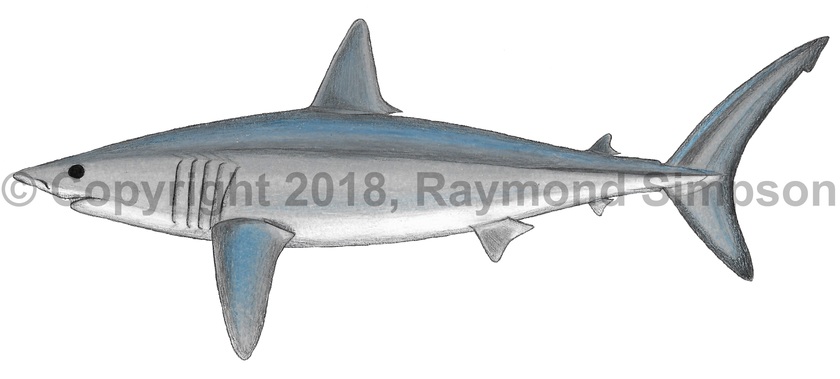
Common Name
Shortfin Mako
Year Described
Rafinesque, 1810
Identification
Upper jaw: 24-26 rows
Lower jaw: 24-29 rows
A large, slender yet robust shark. Snout relatively long and pointed. Eye large. Nostrils closer to mouth than tip of snout. Mouth wide and strongly curved. Labial furrows distinct. Teeth slender, recurved and asymmetrical without serrations. Gill slits number five and are very long (3/4 of body depth). Posterior two slits compressed together before pectoral fin base with fifth slit right at origin. Body tapering posteriorly. Caudal peduncle much wider than tall with a high lateral keel and no secondary keel. First dorsal fin origin posterior to free rear tip of pectoral fin. D1 straight to convex on rear edge. Second dorsal fin tiny. Pectoral fin large and falcate with a convex rear margin. Pelvic fin much larger than D2 and far behind level of D1. Anal fin about the size of D2 and originates almost right below D2. Caudal fin with precaudal pits above and below. Caudal fin lunate with a long lower lobe and a small notch on upper lobe.
Color
Dorsum bright blue, blue-black, or purple, becoming abruptly pale blue on flanks and white on belly. No markings on body or fins. Fins body colored. Eye black.
Size
Mature adults from 180-300cm TL. Maximum size possibly over 400cm TL. Juveniles at least 60cm TL. Females average larger than males.
Habitat
A pelagic shark, found from the surface to 750m. Widespread in both temperate and tropical waters but much more common in deep, open waters. A fish feeder.
Range
Canada to Argentina, including the Caribbean Sea. Continental and oceanic.
References
Castro, J.I. 2011. The Sharks of North America. Oxford University Press, 640 pp.
Ebert, D. A., & M. Dando. 2020. Field Guide to Sharks, Rays & Chimaeras of Europe and the Mediterranean. Princeton University Press. 2020.